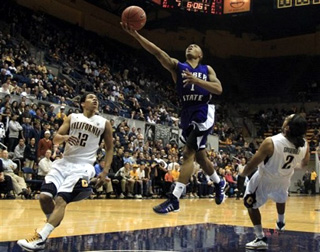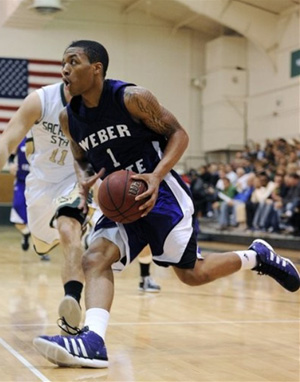Few college hoops fans had heard of Weber State’s Damian Lillard coming into the season.
Playing for Mid Major Weber State (Ogden, UT), he received a medical redshirt after injuring his foot nine games into last season.
NBADraft.net first got a chance to scout Lillard at the adidas Nations camp in the summer of 2010 in Chicago, (and once again in LA at the same event in 2011) and came away very impressed projecting him as a first round pick. It was not unanimous however as there were scouts in attendance (in Chicago) that felt he wasn’t a lock to be drafted due to a low release point on his jump shot and questionable point guard skills.
Fast forward two years and Lillard is on the brink of being a top 10 pick and considered the top point guard prospect available for this year’s draft, even drawing comparisons to former Duke standout Jay Williams.
So, how does such a stellar player fly under the radar as much as he has during his time in college? Well, for one, he was hiding out in the Big Sky conference. Even though they combined for only 3 in-conference losses this season, Montana and Weber State just don’t amount to appointment television. They fell short of the NCAA tourney and thus Lillard didn’t get the opportunity to play on national tv the way players at major conference schools do.
Coming out of Oakland, California, Lillard received little interest from high-major schools, with the Pac-10 passing on him. The fact that he was a late bloomer is seen as a positive as he bypassed the coddling and accompanying sense of entitlement from AAU play that derails many talented prospects.
Despite the lack of national exposure, Lillard isn’t flying under the radar of NBA scouts and general managers. Draft analysts/scouts have him rated at or near the top of their draft boards for his position.

There are obviously questions surrounding Lillard. Workouts leading up to the draft will be especially important for him. People want to know if he can play with players from big time schools. Those that believe in him will implore you to look at his stats over the course of his 104 collegiate games. His detractors will ask you to imagine the stats players like Kentucky’s Marquis Teague, Washington’s Tony Wroten, or Kansas’ Tyshawn Taylor would have put up playing in a mid-major conference. But with Lillard, stats don’t tell the whole story.
As previously mentioned, he suffered a foot injury last year that cost him all but 9 games. Despite being unable to play, he focused on getting better as a player. He studied game tape and was a workout machine. He never let up, and it’s now paying major dividends for the young guard from Oakland (home of other notable point guards Gary Payton and Jason Kidd). He came back from his injury stronger and better than ever.
This past season, he set career highs in just about every important category. His scoring, assists, and rebounds took a jump up, his shooting percentages spiked, his turnovers came down and he made 88% of his 257 free throw attempts.

Scouts will have to determine if this is a product of him playing on a team lacking talent around him, or if it will continue even at the next level. He isn’t an elite ball handler, either, which could cause issues for him.
Fortunately for him, he’s faced adversity before. He has done nothing but improve all facets of his game during his time in the collegiate ranks. Due to his medical redshirt resulting from his foot injury, he could have elected to remain in college for another year, but chose to become an early entrant. With a draft class that is thin at the point guard position, he has the opportunity to go as high as mid lottery. Lillard is one of the best conditioned athletes in the draft, as he never lets up, having averaged over 34.5 minutes per game last season, so he’s used to going all out with little rest.
Lillard may have gone mostly unnoticed by the casual fan, but when the draft rolls around, NBA teams will be looking to trade up for the opportunity to select him. He may not be a prototypical point guard, but in today’s NBA –where point guards are relied on to get into the paint and collapse defenses thanks to the elimination of hand checking on the perimeter –he could be a perfect fit as a high level point guard. It may take time for him to develop the point guard skills to become a stand out and get used to playing against the best of the best on a nightly basis, but it would be unwise to doubt him. Opponents doubted him and he torched them. People doubted he’d come back from his injury and he came back even more explosive than he was before. Now, it’s time for him to show the NBA just how good Damian Lillard really is.

He’s the real deal folks!!!
He’s the real deal folks!!!
portland
portland should take him at 6